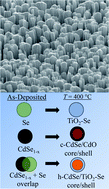Nanostructured homogenous CdSe–TiO2 composite visible light photoanodes fabricated by oblique angle codeposition†
Abstract
A unique fabrication method, oblique angle codeposition, is used to deposit well-aligned

* Corresponding authors
a
Department of Physics and Astronomy, and Nanoscale Science and Engineering Center, University of Georgia, Athens, Georgia 30602, USA
E-mail:
georgelarsen@physast.uga.edu
Fax: +1 (706) 542-2492
Tel: +1 (706) 542-6230
b Department of Chemistry and Biochemistry, University of California, Santa Cruz, California 95064, USA
c Institute of Chemistry, University of Campinas – UNICAMP, P.O. Box 6154, Campinas, SP, Brasil
A unique fabrication method, oblique angle codeposition, is used to deposit well-aligned

 Please wait while we load your content...
Something went wrong. Try again?
Please wait while we load your content...
Something went wrong. Try again?
G. K. Larsen, B. C. Fitzmorris, C. Longo, J. Z. Zhang and Y. Zhao, J. Mater. Chem., 2012, 22, 14205 DOI: 10.1039/C2JM32551A
To request permission to reproduce material from this article, please go to the Copyright Clearance Center request page.
If you are an author contributing to an RSC publication, you do not need to request permission provided correct acknowledgement is given.
If you are the author of this article, you do not need to request permission to reproduce figures and diagrams provided correct acknowledgement is given. If you want to reproduce the whole article in a third-party publication (excluding your thesis/dissertation for which permission is not required) please go to the Copyright Clearance Center request page.
Read more about how to correctly acknowledge RSC content.
 Fetching data from CrossRef.
Fetching data from CrossRef.
This may take some time to load.
Loading related content
